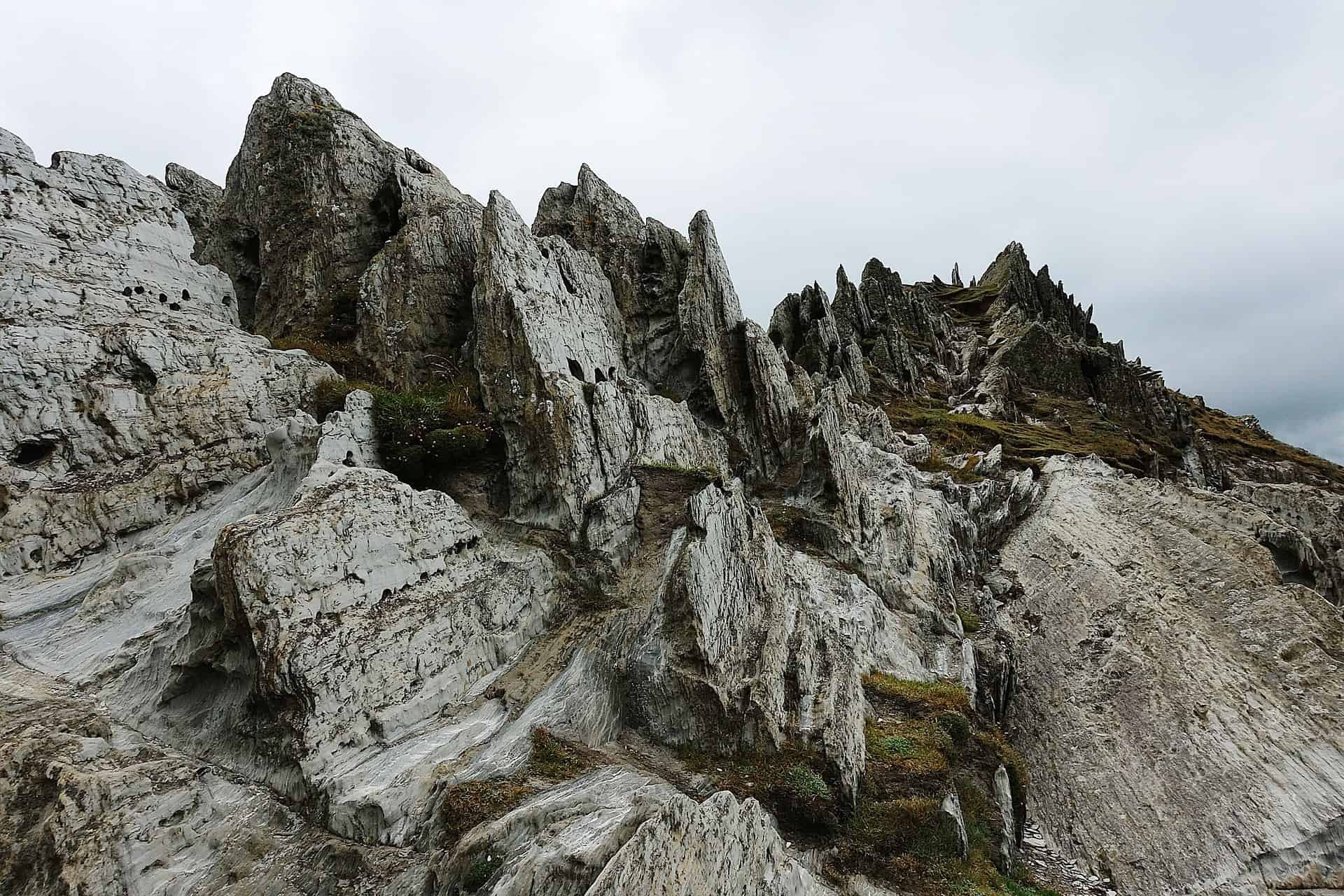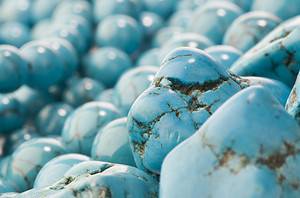Although most of us think of them as inanimate objects that “lie around,” rocks are a fascinating collection of solid items on the planet (and in outer space).
Metamorphic rocks, in particular, are intriguing because of their beautiful elements. And many of them, you know really well. Marble, for instance, is a metamorphic rock. Like soapstone and quartzite, builders use these rocks in kitchens across the planet.
Not all metamorphic rocks are alike, though, so let’s take a look at the many types and see what they are.
What are Metamorphic Rocks?

Metamorphic rock may have a grain-like appearance.
©
Basically put, metamorphic rocks are rocks that have changed from one type of rock to another. Technically, even metamorphic rocks can become new metamorphic rocks, too, and how they do this is through a second change.
Immense pressure, chemical processes, or extreme heat turn metamorphic rocks into new rocks. Exposure to these factors changes the mineralogical makeup of the rock, along with its texture and chemical composition. Typically, this process happens deep within the earth’s crust, far below the surface of the planet. This could be below the oceans or below the land.
There are two types of metamorphic rocks: foliated and non-foliated. Foliated metamorphic rocks have layered, striped, or banded appearances caused by immense indirect heat (not direct contact with magma) or direct pressure. Non-foliated metamorphic rocks, on the other hand, have gone through this process but don’t have a layered or striped appearance.
To learn more about metamorphic rocks, check out the article we’ve written about what they are, how they’re formed, and what the difference is between foliated and non-foliated metamorphic rocks.
What are Metamorphic Rocks Used For?
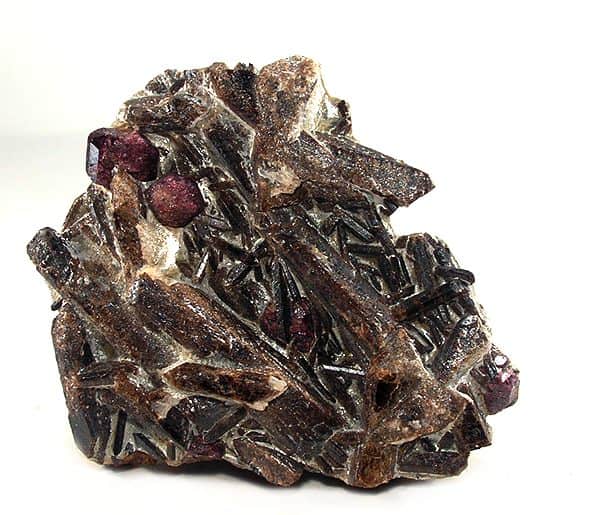
Metamorphic rock containing staurolite and almandine garnet
©
The type of metamorphic rock will determine its use, largely dependent on the minerals within the rock. The two most often used metamorphic rocks are marble and quartzite. Marble is commonly used in sculpture and artwork, along with decorative construction. It’s also often ground up and used in plastics, paper, and even toothpaste, in some cases. Quartzite is probably best known for its uses in kitchens as countertops. Quartzite is sometimes crushed up and used in the construction of railroad tracks. Schist and slate may be used in landscaping, while slate may also be used in roof shingles.
Types of Metamorphic Rocks
Because metamorphic rocks are made up of such a wide range of origin, mineralogical, and chemical makeups, metamorphic rocks are classified the way other types of rocks are. Magma or lava cooling and solidifying forms igneous rocks. Sedimentary rocks form when particles settle, accumulate layers, and harden. Metamorphic rocks are classified by fabric, mineralogy, or origin since they can be made up of any type of rock originally.
Serpentinite
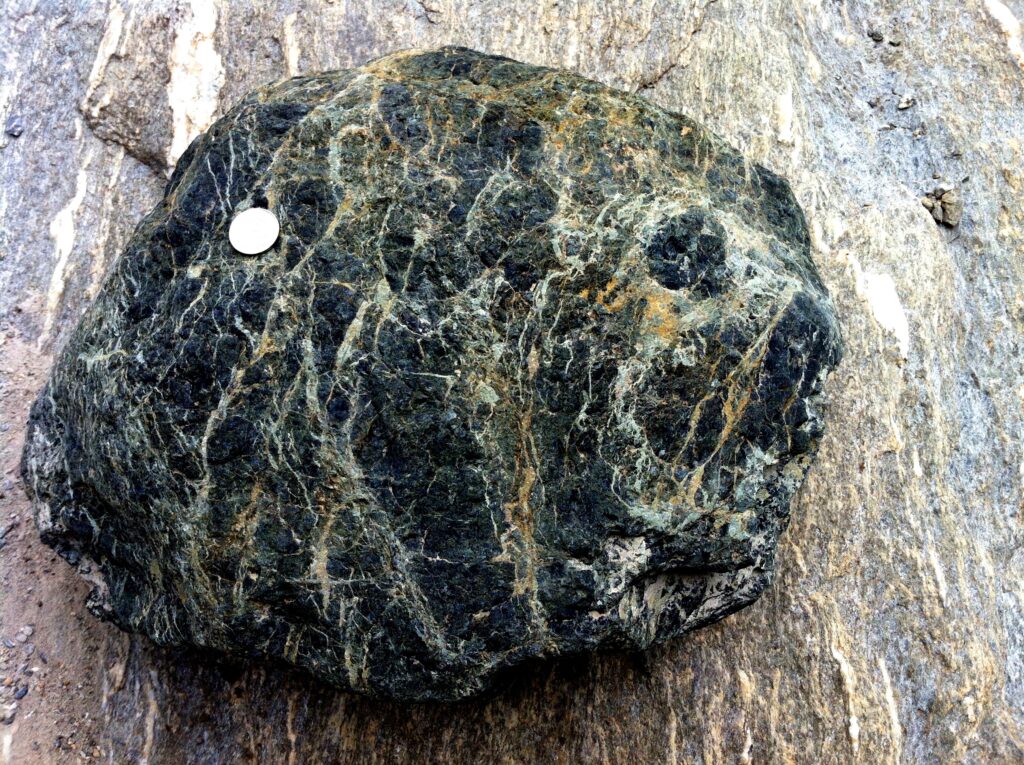
Serpentinite often looks a bit like snakeskin, though it may be less obvious in some specimens.
©
This type of metamorphic rock looks a bit like snakeskin, earning it the name Serpentinite. Regional metamorphism in the ocean mantle deep in the sea forms this rock. The appearance is waxy and mottled in coloring, with a mildly soapy feel. The rock is located in many locations, including California, where it is the state rock.
The rock is made up of primarily one or more of “lizardite,” “antigorite,” or “chrysotile” which are the three magnesium silicate minerals. Serpentinite or serpentine rocks, as they are commonly known, are thought by geologists to be the metamorphized remains of magnesium-rich igneous rocks.
Serpentinite is used most often for ornamental or decorative purposes, including in sculptures and architecture.
Phyllite

Phyllite with sparkling minerals revealed
©
Typically in shades of gray, sometimes with some hints of green, phyllite is a distinctive metamorphic rock with some shine on it. These rocks also often have fine white veins running through them and the texture is similar to slate. If you compare them, though, phyllite will have that shine and the slate won’t.
The fine veins come from the compression. If the rock is compressed more, at a significant enough pressure, it will “grow” more veins along the surface of the rock.
Phyllite breaks off with grooves and divots. Thus, though similar to slate, it isn’t used as commonly as slate. Phyllite is still often used as facing stone, building exterior material, decorative aggregates, and floor tiles. It is used in cemetery markers, commemorative tablets, writing slates, and artwork, as well.
Phyllite may be found in sedimentary basins deeply buried all over the world, from the North American Appalachian mountains to the Alps in Europe and the Himalayas. Largely, the rock exists in mountainous regions.
Gneiss
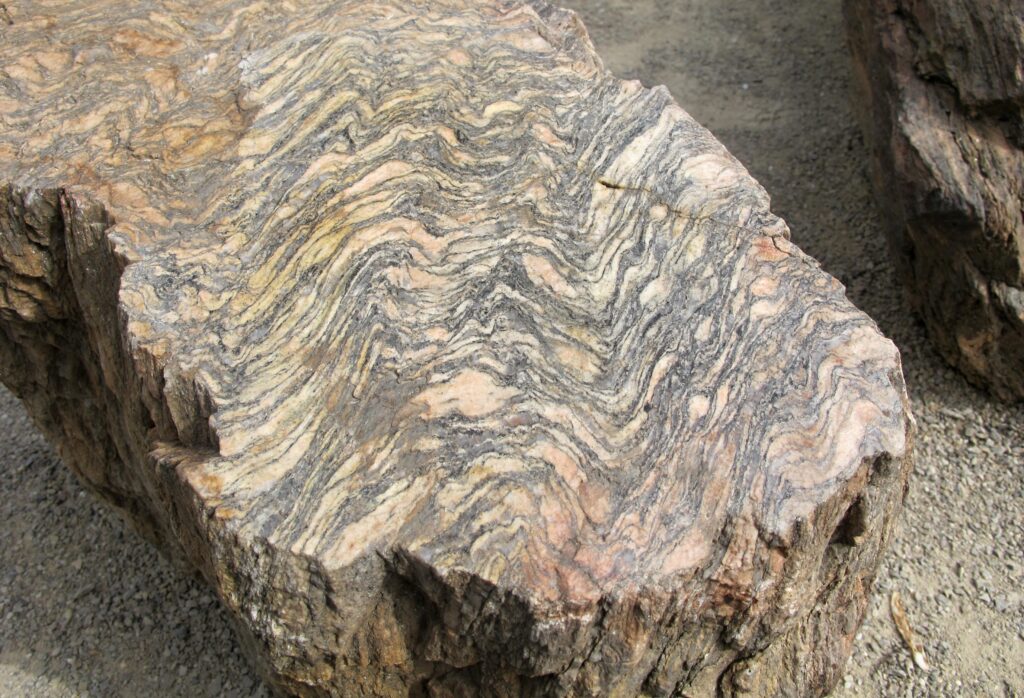
Gneiss rocks may come in a wide range of appearances thanks to their formation from igneous or sedimentary rocks.
©
Another common metamorphic rock formed by regional metamorphism is gneiss, which comes in two categories: paragneiss and orthogneiss. Orthogneiss is made from igneous rock and paragneiss is made from sedimentary rock. Either type of gneiss is foliated (banded) and typically comes in white with dark gray bands, sometimes with touches of copper.
Less than 50% of the rock is made up of the materials that form these bands (minerals), which is why they stand out and create the banded appearance. The layers are uneven, often thin, and may appear like stripes or veins. And, like phyllite, if left in great pressure areas, gneiss will continue to metamorphize and ultimately become granite.
Northern Canada is where you’ll find lots of gneiss, which is believed to be the oldest type of rock in the world and is believed to make up the largest chunk of the earth’s lower crust.
Gneiss is used in many construction projects, such as flooring, facing on buildings, work surfaces, and ornamental stones and gravestones.
Eclogite
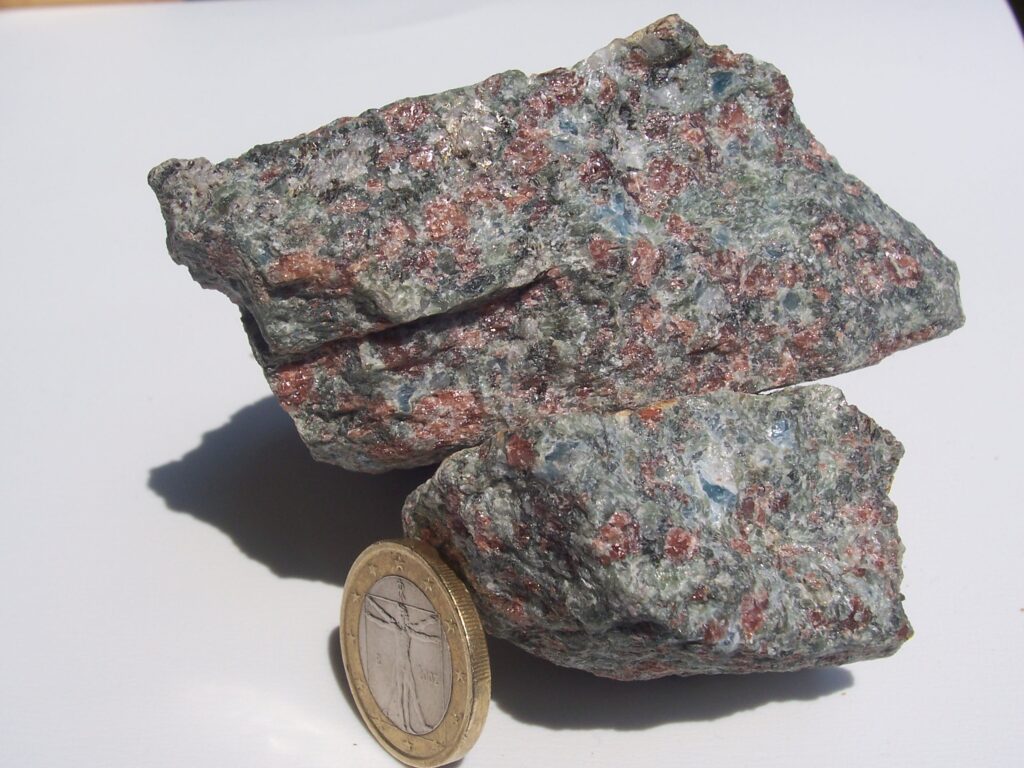
Eclogite rock, with a Euro for perspective on the size of patterns in the rock.
©
Formed by regional metamorphism of basalt under extremely high pressures and temperatures, eclogite is considered one of the highest-grace metamorphic facies. Eclogite contains garnet along with other minerals, such as kyanite, rutile, quartz, or coesite. The rock consists primarily of green pyroxene and red garnet, with other amounts of minerals. Usually appearing in “spots” or dots.
Eclogite is a rare metamorphic rock that is largely in Greenland. It is the world’s densest rock of siliceous matter and is used most often for abrasives, monuments, and roads due to its density.
Schist

The “scaly” appearance of schist is vivid in this specimen.
©
Also created through regional metamorphism, schist is made up of coarse mineral grains that have been split into thin layers. The high pressure and extreme heat in regional metamorphism causes these minerals to align with the other components like mica to create schist. Schist is characterized by at least 50% of the minerals arranged into thin layers within the rock.
Schist rocks are typically found in Precambrian age rocks, where eroded mountains or glacial deposits reveal the rocks. Because the rock isn’t particularly durable, it is more often used in garden decorations, landscaping, and some sculptures.
Greenschist
As the name implies, greenschist is a form of schist rock that is green in color. It is made up of 50% or more of the green mineral, chlorite, which gives its coloring.
Blueschist
Blueschist is most often created in marine territories when the marine crust is dragged beneath a continental plate and then exposed later on after metamorphism occurs. And while the name indicates blue coloring – which is present in many blueschist rocks – it is not always present. Rather, blueschist is made up of at least 50% amphibole or glaucophane. The ones with the highest deposits of sodium will have a blue coloring.
Mica-schist
Mica-schist is one of the shiniest shists, as it is made up of at least 50% mica, a sparkling mineral.
Graphite-schist
Graphite-schist is rich in graphite and otherwise meets the components of schist.
Amphibolite
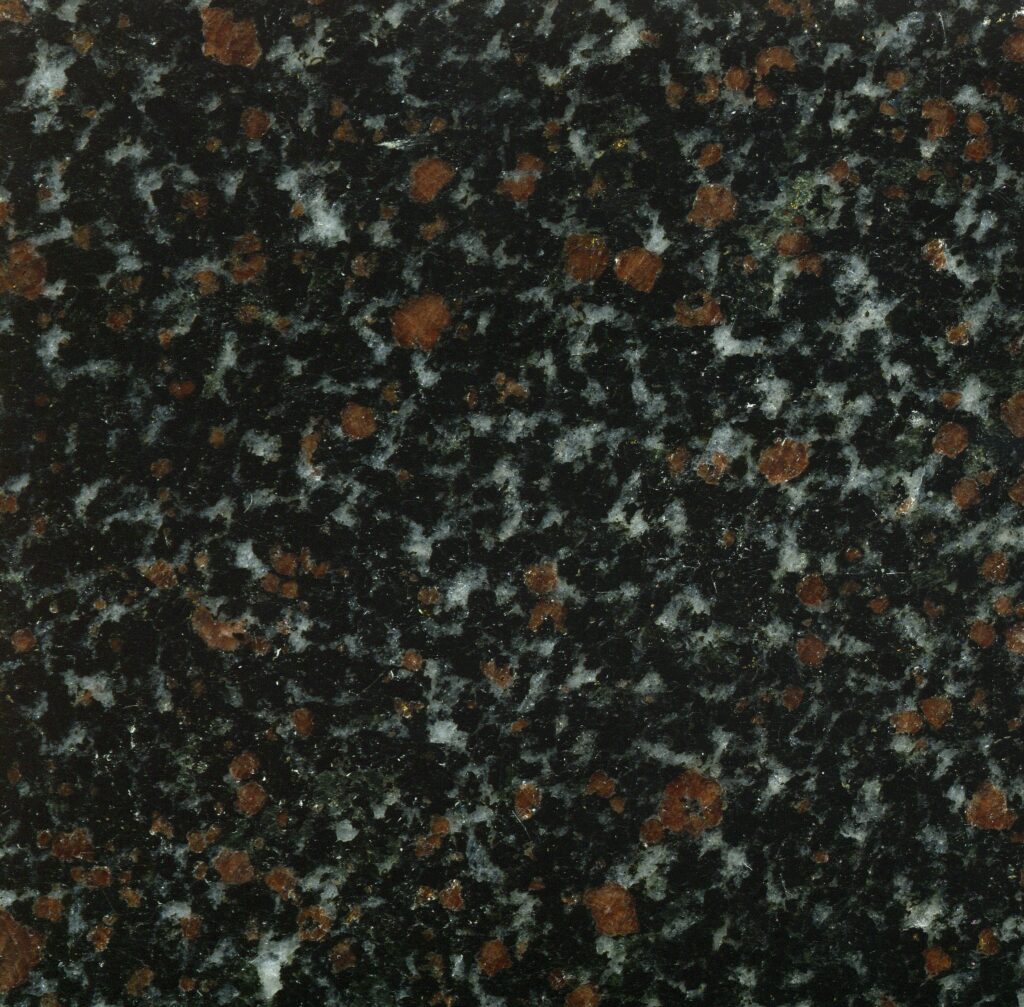
The garnet is clearly present in this amphibolite specimen.
©
Made up largely of amphibole minerals, amphibolite is a high-heat exposure metamorphic rock. The rocks start out as basaltic rocks and the heat transforms them into this metamorphic rock. The rock has colorful “spots” somewhat reminiscent of certain amphibious creatures, as well, with coloring ranging widely between red and black on gray to green and off-white shades, and everything in between. This wide coloration is because of the wide range of minerals that may be within the stone: kyanite, sillimanite, epidote, garnet, wollastonite, andalusite, staurolite, or biotite.
Most often, amphibolite will be used for paving, facing buildings, and construction. The rock is readily available and easy to polish, which gives it fairly high favor in these areas of use.
Slate

Slate comes in typically gray shades.
©
A common metamorphic rock used around the home is known as slate. This is the flat, “flaky” looking rock that we often find in our patio pavers, stone tiles, and similar household construction and landscaping materials. The texture of slate is smooth, with a typical uniform gray coloring, though some slate will have other colors as well. Slate is formed from clay minerals and is easy to split, which is part of why it is often used for simple construction. Slate is abundant in many locations around the world.
Argillite
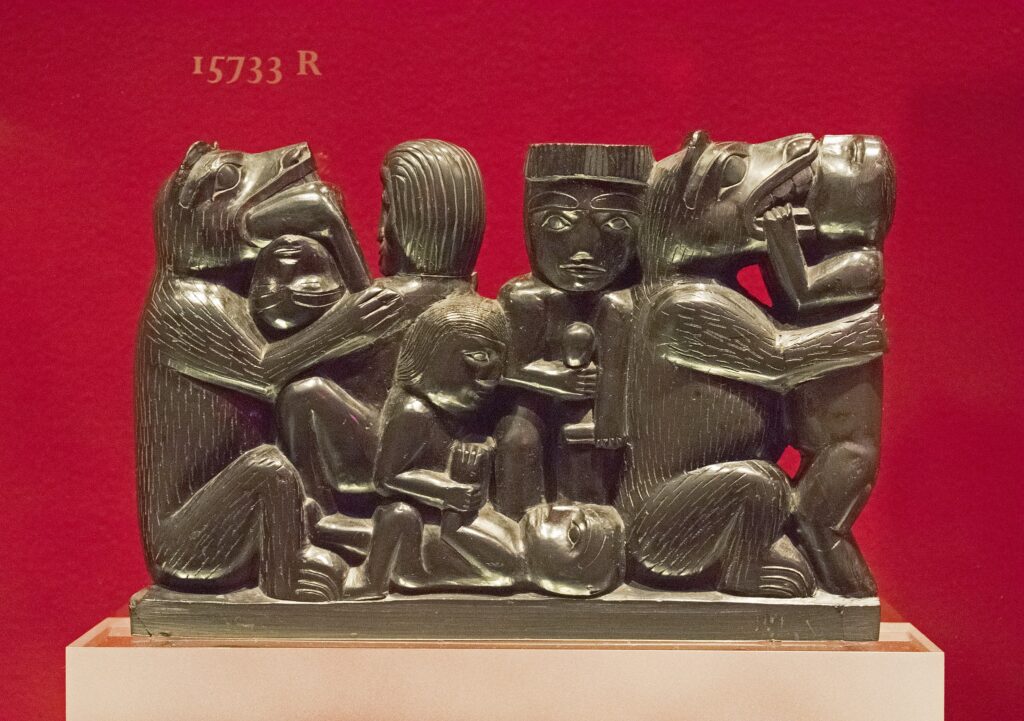
“Black slate” as argillite is commonly known in some regions, is used largely in Haida culture and artwork.
©
Argillite looks similar to slate, being metamorphized from claystone under moderate pressure and temperatures. However, the rock lacks the typical cleavage of slate. The stone is also known as pipestone. The stone is easily carved and has long been used by Native Americans to create pipes, decorative pieces, and other decorative objects – earning the stone its nickname of pipestone – while Maori and other Indigenous peoples use the stone for a wide range of uses, including tools.
Argillite is also found widely spread across the planet, though certain types of argillite (such as Haida argillite) may be found exclusively in given locations. The stone is used for carving, as well as sinks, countertops, and roofing, apart from the artistic and ceremonial uses.
Cataclasite
Composed of very fine grains created by the grinding of rocks, cataclasite is a metamorphic rock that typically lacks an oriented fabric. The rocks are formed through the progressive fracturing of mineral grains and aggregates, combined with frictional sliding and rotation of grains during the pressure process of metamorphism. The rock is generally speckled or spotted and comes in a range of colors. You see it in buildings, facings, paving, curbing, cement manufacturing, road and construction aggregate, and sometimes in creative artwork.
Quartzite

Quartzite is typically sparkling like this specimen, at least when examined up close.
©
One of the most commonly known metamorphic rocks is quartzite, a stone that has a strong crystalline structure and therefore often has sparkling speckles and veins. The hard, dense rock is formed by regional metamorphism from chert or sandstone. It’s usually white or gray, though there is a light shade of pink that may be found (due to iron oxide in the sand formed into the quartzite).
This rock is often used to build both indoor and outdoor kitchen countertops, to cover walls, as roofing tiles, in flooring, and stairsteps. It is also crushed and used in road construction.
Soapstone

Samples of soapstone in white, gray, and multi-colored (reddish) shades
©
Another popular countertop material is soapstone. This one is less frequently used in outdoor kitchens, however, because of the unique quality that gives the stone its common name. When wet, the stone feels “soapy” and is highly porous. Soapstone is formed from the mineral talc, which is rich in magnesium. The stone is more commonly used in carvings and cookware, like griddles, and may also be used to make sinks, and pizza stones, and to line the interior of commercial ovens.
Greenstone

Greenstone is frequently used for carving. (
El Señor de las Limas
, the largest known greenstone sculpture,
Xalapa Museum
)
©
As the name implies, greenstone is, yes, largely a stone of green coloring. It is formed from basaltic rock, either peridotite or olivine. When these stones are put under immense pressure and moderate temperatures, greenstone is formed. The stone rarely makes it to the surface of the earth, so it is less commonly found. The name is sometimes given to other rocks – simply because of the color – so you may find greenstone used in carvings, jewelry, statuettes, and ritual or ceremonial tools commonly around the world.
Marble
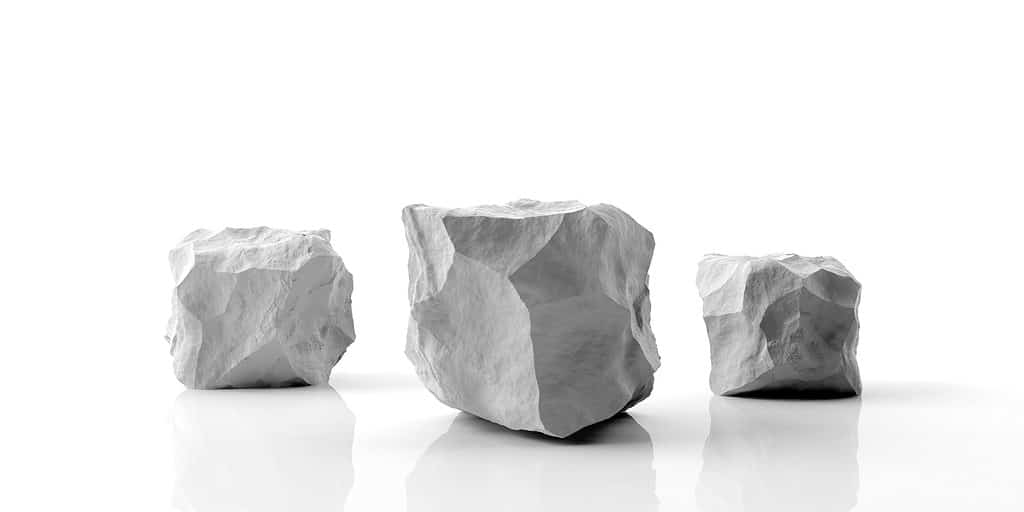
Marble is perhaps the most well-known of all metamorphic rocks, thanks to its frequent use in ornate construction and statuary.
©iStock.com/Rawf8
Perhaps the most well-known of all metamorphic rocks is marble. The stunning rock has been used for many things throughout the history of humanity, including the construction of columns for ornate structures and carving into statues and busts. It is used in flooring, countertops, tabletops, monuments, and much more. The rock is derived from either dolomite or limestone and is durable and attractive. The rock is typically pure white or dark black, but often the stone has a “marbling” look of both light and dark colors, thus giving the effect its name.
Mylonite

A microscopic view of mylonite shows the intense, vivid coloring and brightness of periodotitic stone.
©
Mylonite is another attractive metamorphic rock with veining, stripes, and even marbling, depending on the rock. This particular rock is formed as the rock is stretched and crushed under both intensive heat and massive pressure. The formation of the rocks is actually a bit the way plastic is formed. This intriguing stone is often used as a landscaping stone, in creating milestones and architectural artifacts, in road aggregate, and in various aspects of construction.
Hornfels
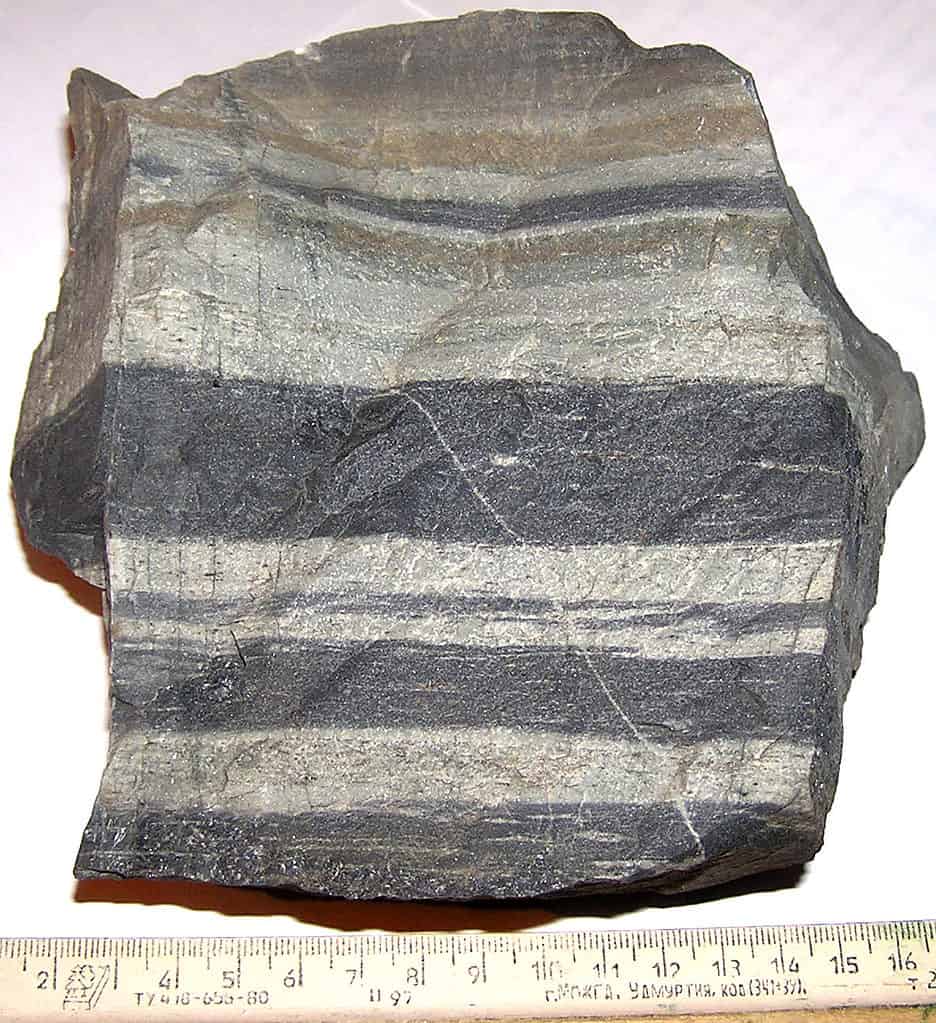
Hornfels have a distinctive banding to them.
©
A foliated, fine-grained metamorphic rock, hornfels are typically darker gray with distinctive layers in lighter gray and white. Contact metamorphism forms these rocks, meaning the rock was exposed to indirect extreme heat (typically near molten lava or hot magma). Because of the strength and attractive patterning of hornfels, builders use them for beautification and architectural decoration when constructing residential and commercial buildings. They also use them for flooring, exterior facing, curbing, decorations, and paving.
Migmatite
Migmatite is made from the same kinds of rocks that gneiss is made from. In this case, they come closer to the melting point than gneiss does. This occurs through regional metamorphism. Migmatite has layers that form chaotic-looking waves and spots or patterns, with darker and lighter rocks merging to create the patterns. The darker shades are often from hornblende or mica and the lighter from feldspar or quartz.
The attractive patterns in migmatite and its polishable surface and durability all make the rock ideal for countertops, flooring, kitchen work, curbing, road aggregates, cement manufacture, and dimension stones, as well as ornamental uses in other forms of construction.
Summary of 16 Types of Metamorphic Rocks
| Number | Metamorphic Rock |
|---|---|
| 1 | Serpentinite |
| 2 | Phyllite |
| 3 | Gneiss |
| 4 | Eclogite |
| 5 | Schist |
| 6 | Amphibolite |
| 7 | Slate |
| 8 | Argillite |
| 9 | Cataclasite |
| 10 | Quartzite |
| 11 | Soapstone |
| 12 | Greenstone |
| 13 | Marble |
| 14 | Mylonite |
| 15 | Hornfels |
| 16 | Migmatite |
Thank you for reading! Have some feedback for us? Contact the AZ Animals editorial team.

